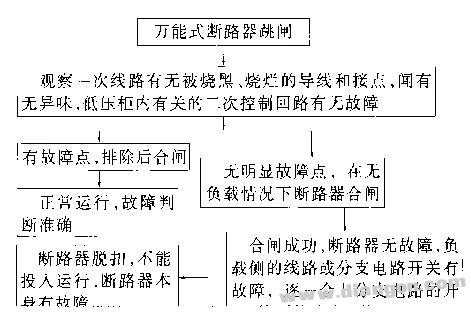The universal circuit breaker trips and fails to re-close
1. First determine if the circuit breaker is a non-accident trip. Non-accident trip refers to tripping without a short circuit or overload fault. There are many reasons why the circuit breaker cannot be closed. First, it is necessary to determine whether the circuit is short-circuited or tripped due to overload, or whether the circuit breaker itself or the control circuit is faulty. The following block diagram is used to illustrate the steps and methods for finding and determining whether a line fault or a breaker fault (Figure 1).
After determining that the circuit breaker is faulty, pull out the circuit breaker (refer to the drawer circuit breaker) for inspection.
2. Universal troubleshooting of universal circuit breakers
(1) The failure of the circuit breaker to close the voltage due to the loss of power of the undervoltage release or the failure of the undervoltage release coil coil will cause the circuit breaker to trip and cause the switch to fail to be reclosed. The following four conditions can cause the undervoltage release coil to lose power.
1 The protection circuit fuse is blown, such as RT14, causing the loop to fail, and the trip coil of the undervoltage release is de-energized;
2 If the closed button, relay contact, and auxiliary contact of the circuit breaker are in poor contact, the components may be damaged, which may cause the loop to be unreachable and the trip coil to lose power;

Figure 1 Steps and methods for determining whether a line fault or a circuit breaker is faulty
The disconnection of the connecting wire in the 3 circuit and the loosening of the crimping screw may also cause the loop to be unreachable and the trip coil to lose power;
4Because the coil of the undervoltage release is in the energized working state for a long time, the environmental pollution and the armature are not flexible or the air gap between the iron core and the armature is too large, so that the current is too large and the trip coil is heated and burned. Loss of the function of the trip coil.
The above faults can be correctly judged by observation and simple inspection test, so if the fault point is found, it should be eliminated in time. If the joint is loose, it should be tightened, and the component damage and coil burnt need to be replaced.
(2) The mechanical system is faulty, causing the circuit breaker to fail to close the circuit breaker. After several times of tripping and closing, the mechanism is seriously worn and the following faults may occur.
1 The motor drive mechanism is worn out. If the worm gear and the worm of the ME switch are damaged, the operating mechanism of the circuit breaker cannot be driven to buckle and close. The replacement of the worm gear and the worm is more complicated and requires professional maintenance.
2 The free tripping mechanism wears out, making the circuit breaker difficult to buckle again, and the tripping is easy. Sometimes it is barely buckled. When it is vibrated, it will trip off by itself; sometimes, after the buckle is released, the closing will be buckled. At this time, the adjusting screw should be rotated to adjust the relative position of the tripping half shaft and the jumper so that the contact area is about 2.5mm2, and if necessary, replace the corresponding parts.
3 operating mechanism energy storage spring failure. The breaking energy storage spring of the operating mechanism relaxes or loses elasticity after multiple stretching, and the closing force becomes small. When closing, the four-bar linkage of the circuit breaker cannot be pushed to the dead position, and the mechanism cannot be kept in the closing position. Therefore, the circuit breaker also cannot be closed normally. The energy storage spring must be replaced.
4 The operating mechanism is not flexible and has a stuck phenomenon. Since the circuit breakers are not fully enclosed, if the foreign objects such as screws and nuts are accidentally left in the operating mechanism, the circuit breaker operation is stuck, which will affect the closing; in addition, the rotating and sliding parts lack lubricating grease. The breaking energy storage spring of the operating mechanism is slightly deformed, and the circuit breaker will not close the brake. Therefore, in the case of the above-mentioned failure, in addition to checking whether there is foreign matter in the operating mechanism, it is necessary to inject lubricating grease into the rotating and sliding portions.
Marine Pneumatic Mooring Winches
Pneumatic Winches,Pneumatic Mooring Winches,Marine Air Mooring Winches,Marine Pneumatic Mooring Winches
RUDONG HONGXIN MACHINERY CO.,LTD , https://www.rdhxmfr.com
